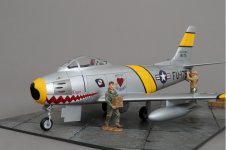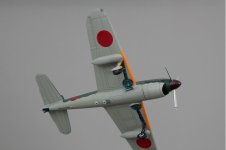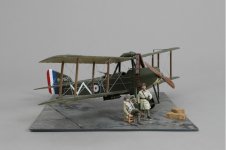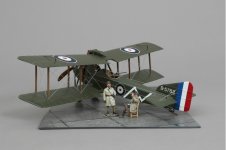Gunn Miniatures
Command Sergeant Major
- Joined
- Jun 18, 2009
- Messages
- 2,697
F-86 Sabre
The North American F-86 Sabre, sometimes called the Sabrejet, was a transonic jet fighter, produced by North American Aviation. The Sabre is best known as the United States' first swept wing fighter that could counter the swept-wing Soviet MIG-15 high-speed dogfights in the skies of the Korean War (1950–1953), fighting some of the earliest jet-to-jet battles in history. Considered one of the best and most important fighter aircraft in that war, the F-86 is also rated highly in comparison with fighters of other eras. Although it was developed in the late 1940s and was outdated by the end of the 1950s, the Sabre proved versatile and adaptable and continued as a front-line fighter in numerous air forces.
Its success led to an extended production run of more than 7,800 aircraft between 1949 and 1956, in the United States, Japan, and Italy. In addition, 738 carrier-modified versions were purchased by the US Navy. Variants were built in Canada and Australia. The Canadian Sabre variant added another 1,815 aircraft and the significantly redesigned CAC Sabre (sometimes known as the Avon Sabre or CAC CA-27), had a production run of 112. The Sabre is by far the most produced western jet fighter, with a total production of all variants at 9,860 units.
The F-86 entered service with the USAF in 1949, joining the 94[SUP]th[/SUP] Fighter Squadron and became the primary air-to-air jet fighter used by the Americans in the Korean War. Whilst earlier straight-winged jets such as the P-80 and F-84 and initially achieved air victories, when the swept-wing MIG-15 was introduced in November 1950, it outperformed all UN-based aircraft.
In response, three squadrons of F-86s were rushed to the Far East in December. The MiG-15 was superior to early F-86 models in ceiling, firepower, acceleration, turning, rate of climb, and ability to zoom climb. The F-86 was marginally faster, and could out-dive the MiGs. When the F-86F was introduced in 1953, the two aircraft became more closely matched, and by the end of the war, many American combat-experienced pilots claiming a marginal superiority for the F-86F.
The heavier firepower of the MiG, and many other contemporary fighters, was addressed by “Project Gun-Val” which saw the combat testing of seven F-86Fs each armed with four 20 mm cannons (such F-86s were designated as F-86F-2s). Despite being able to fire only two of the four 20 mm cannon at a time, the experiment was considered a success and signaled the end of the decades-long use of the Browning .50 calibre in the air-to-air role.
Although the F-86A could be safely flown through Mach 1, the F-86E's all-moving tailplane greatly improved maneuverability at high speeds. The MiG-15 could not safely exceed Mach 0.92, an important disadvantage in near-sonic air combat. Far greater emphasis had been given to the training, aggressiveness, and experience of the F-86 pilots.
In October 1951, the Soviets managed to recover a downed Sabre, and in their investigation of the type they concluded that the Sabre's advantage in combat was due to the APG-30 gun-sight that facilitated accurate fire at longer ranges.
By the end of hostilities, F-86 pilots were initially credited by American sources with shooting down 792 MiGs for a loss of only 78 Sabres in air-to-air combat, a victory ratio of 10:1. Of the 41 American pilots who earned the designation of Ace during the Korean War, all but one flew the F-86 Sabre, the exception being a Navy Corsair night fighter pilot. However, after the war, the USAF reviewed its figures in an investigation code-named Sabre Measure Charlie and downgraded the kill ratio of the North American F-86 Sabre against the MIG-15 by half, to 5:1. Internally, the USAF accepted that its pilots had actually downed about 200 MiGs.
Soviet data records only 335 MiG-15s in Korea to all causes, including accidents, antiaircraft fire, and ground attacks. Chinese claims of their losses amount to 224 MiG-15s in Korea. North Korean losses are not known, but according to North Korean defectors, their air force lost around 100 MiG-15s during the war. Thus, 659 MiG-15s are admitted as being lost, many of these to F-86 Sabres. The Soviets claimed to have downed over 600 Sabres, together with the Chinese claims (211 F-86s shot-down), although these cannot be reconciled with the number of Sabres recorded as lost by the US.
For those of you interested we have some Mig-15's coming later this year.
We have 3 Sabre variants available:
WOW525 The Huff flown by Lt. Jim Thompson piloted this aircraft out of Suwon AFB South Korea. In May 1953 he scored his first kill, a Russian MiG-15 flown by a Chinese pilot. The MiG had a marvelous dragon painted on the nose which enamoured Jim so much he ran to his crew chief asking if he could paint one on the side of his F 86. The result was one of the most stunning schemes of the whole Korean conflict. He delivered his second kill in July 1953. Two models available.
WOW526 Peg O My Heart flown by Ace Capt Joseph Fields, two available.
WOW527 Mig Mad Marine flown by John Glen who went onto become one of the worlds first astronauts. Two models available.
This 1/30 scale model priced at $799 plus shipping. Model measures 40cm wide by 37.5cm long approx.
The TG accessories/K&C figures are shown for scale comparison purposes only and are not included.



That's all for this month, we sincerely hope you enjoy the pictures and would love to hear from you if any of these magnificent models appeal to you. They are all now on our website www.tomgunn.co.uk and can be paid for upfront or over an extended monthly period.
All Gunn Club members qualify for a 5% discount on the website listed price, joining is free so well worth registering.
Best wishes The Gunn Team
The North American F-86 Sabre, sometimes called the Sabrejet, was a transonic jet fighter, produced by North American Aviation. The Sabre is best known as the United States' first swept wing fighter that could counter the swept-wing Soviet MIG-15 high-speed dogfights in the skies of the Korean War (1950–1953), fighting some of the earliest jet-to-jet battles in history. Considered one of the best and most important fighter aircraft in that war, the F-86 is also rated highly in comparison with fighters of other eras. Although it was developed in the late 1940s and was outdated by the end of the 1950s, the Sabre proved versatile and adaptable and continued as a front-line fighter in numerous air forces.
Its success led to an extended production run of more than 7,800 aircraft between 1949 and 1956, in the United States, Japan, and Italy. In addition, 738 carrier-modified versions were purchased by the US Navy. Variants were built in Canada and Australia. The Canadian Sabre variant added another 1,815 aircraft and the significantly redesigned CAC Sabre (sometimes known as the Avon Sabre or CAC CA-27), had a production run of 112. The Sabre is by far the most produced western jet fighter, with a total production of all variants at 9,860 units.
The F-86 entered service with the USAF in 1949, joining the 94[SUP]th[/SUP] Fighter Squadron and became the primary air-to-air jet fighter used by the Americans in the Korean War. Whilst earlier straight-winged jets such as the P-80 and F-84 and initially achieved air victories, when the swept-wing MIG-15 was introduced in November 1950, it outperformed all UN-based aircraft.
In response, three squadrons of F-86s were rushed to the Far East in December. The MiG-15 was superior to early F-86 models in ceiling, firepower, acceleration, turning, rate of climb, and ability to zoom climb. The F-86 was marginally faster, and could out-dive the MiGs. When the F-86F was introduced in 1953, the two aircraft became more closely matched, and by the end of the war, many American combat-experienced pilots claiming a marginal superiority for the F-86F.
The heavier firepower of the MiG, and many other contemporary fighters, was addressed by “Project Gun-Val” which saw the combat testing of seven F-86Fs each armed with four 20 mm cannons (such F-86s were designated as F-86F-2s). Despite being able to fire only two of the four 20 mm cannon at a time, the experiment was considered a success and signaled the end of the decades-long use of the Browning .50 calibre in the air-to-air role.
Although the F-86A could be safely flown through Mach 1, the F-86E's all-moving tailplane greatly improved maneuverability at high speeds. The MiG-15 could not safely exceed Mach 0.92, an important disadvantage in near-sonic air combat. Far greater emphasis had been given to the training, aggressiveness, and experience of the F-86 pilots.
In October 1951, the Soviets managed to recover a downed Sabre, and in their investigation of the type they concluded that the Sabre's advantage in combat was due to the APG-30 gun-sight that facilitated accurate fire at longer ranges.
By the end of hostilities, F-86 pilots were initially credited by American sources with shooting down 792 MiGs for a loss of only 78 Sabres in air-to-air combat, a victory ratio of 10:1. Of the 41 American pilots who earned the designation of Ace during the Korean War, all but one flew the F-86 Sabre, the exception being a Navy Corsair night fighter pilot. However, after the war, the USAF reviewed its figures in an investigation code-named Sabre Measure Charlie and downgraded the kill ratio of the North American F-86 Sabre against the MIG-15 by half, to 5:1. Internally, the USAF accepted that its pilots had actually downed about 200 MiGs.
Soviet data records only 335 MiG-15s in Korea to all causes, including accidents, antiaircraft fire, and ground attacks. Chinese claims of their losses amount to 224 MiG-15s in Korea. North Korean losses are not known, but according to North Korean defectors, their air force lost around 100 MiG-15s during the war. Thus, 659 MiG-15s are admitted as being lost, many of these to F-86 Sabres. The Soviets claimed to have downed over 600 Sabres, together with the Chinese claims (211 F-86s shot-down), although these cannot be reconciled with the number of Sabres recorded as lost by the US.
For those of you interested we have some Mig-15's coming later this year.
We have 3 Sabre variants available:
WOW525 The Huff flown by Lt. Jim Thompson piloted this aircraft out of Suwon AFB South Korea. In May 1953 he scored his first kill, a Russian MiG-15 flown by a Chinese pilot. The MiG had a marvelous dragon painted on the nose which enamoured Jim so much he ran to his crew chief asking if he could paint one on the side of his F 86. The result was one of the most stunning schemes of the whole Korean conflict. He delivered his second kill in July 1953. Two models available.
WOW526 Peg O My Heart flown by Ace Capt Joseph Fields, two available.
WOW527 Mig Mad Marine flown by John Glen who went onto become one of the worlds first astronauts. Two models available.
This 1/30 scale model priced at $799 plus shipping. Model measures 40cm wide by 37.5cm long approx.
The TG accessories/K&C figures are shown for scale comparison purposes only and are not included.



That's all for this month, we sincerely hope you enjoy the pictures and would love to hear from you if any of these magnificent models appeal to you. They are all now on our website www.tomgunn.co.uk and can be paid for upfront or over an extended monthly period.
All Gunn Club members qualify for a 5% discount on the website listed price, joining is free so well worth registering.
Best wishes The Gunn Team







